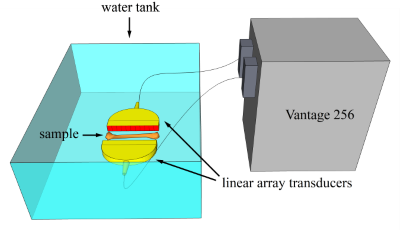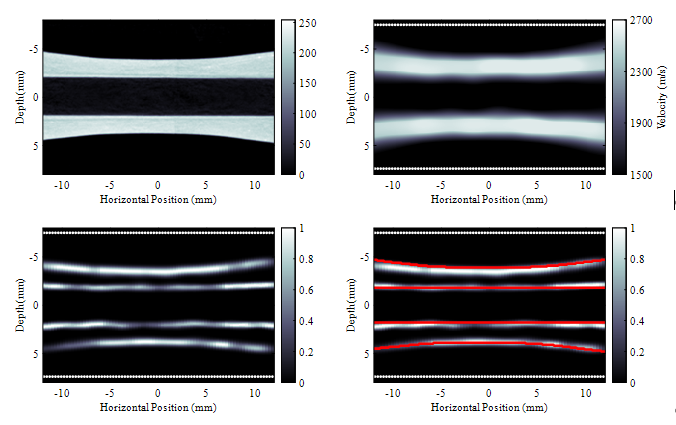Ultrasonic imaging of long cortical bone remains a challenge in the medical ultrasound community. Cortical bone is a medium with high attenuation, heterogeneity, and porosity. There is significant acoustic impedance contrast between the cortical bone and the surrounding soft tissue. Meanwhile, the sound velocity distributions of the cortical bone and the soft tissue are unknown. All these issues lead to the difficulties in cortical bone ultrasound imaging. Due to the uniform sound velocity assumption, the conventional modality with pulse-echo mode can not be able to accurately image the long cortical bone.
Aiming at the importance of sound velocity estimation in bong ultrasound imaging, an ultrasonic imaging method called full-matrix Fourier-domain synthetic aperture based on velocity inversion (FM-FDSA-VI) was developed to provide accurate cortical bone images by the Intelligent Medical Ultrasound Lab. The two identical linear probes with face-to-face setup were utilized to reconstruct the long cortical bone in the axial direction. The method can acquire both the reflected and transmitted ultrasonic waves, successful estimating the sound velocity distribution via travel-time inversion. Based on the estimated sound velocity model, the full-matrix Fourier-domain synthetic aperture method was further applied to accurately reconstruct the long cortical bone. Compared with the traditional synthetic aperture imaging method (SA), the proposed method can precisely implement reconstructions of the regular and irregular long cortical bones in the axial direction. Moreover, it can simultaneously evaluate the elastic and morphological characteristics of long cortical bone.
The relevant research was published inIEEE Transactions on Ultrasonics, Ferroelectrics, and Frequency Controlin Aug, 2021, with the title of“Fourier-domain ultrasonic imaging of cortical bone based on velocity distribution inversion”. Doctor Yifang Li and the doctoral candidate Qinzhen Shi are the co-first authors, and the Post Doctor Xiaojun Song and Professor Dean TA are the corresponding authors. This work was supported in part by the National Natural Science Foundation of China under Grant 11827808, Grant 11874289, and Grant 12034005, in part by the Program of Shanghai Academic Research Leader under Grant 19XD1400500, and in part by the China Postdoctoral Science Foundation under Grant 2019M661334.(Yifang Li, Qinzhen Shi, Yuan Liu, Meilin Gu, Chengcheng Liu, Xiaojun Song*, Dean Ta*, and Weiqi Wang, IEEE Transactions on Ultrasonics, Ferroelectrics, and Frequency Control, 2021, 68(8), 2619-2634)

